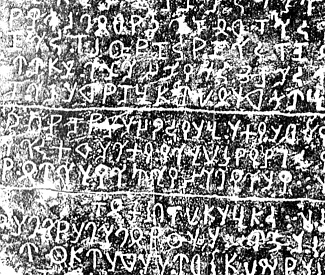

Zitierweise / cite as:
Slater, Gilbert <1864 - 1938>: Some south Indian villages (1918). -- (Quellenkunde zur indischen Geschichte bis 1858 / Alois Payer ; 5. Unbewegliche Hinterlasenschaften, 4.). -- Fassung vom 2008-03-29. -- http://www.payer.de/quellenkunde/quellen054.htm
Erstmals publiziert als:
Slater, Gilbert <1864 - 1938>: Introduction . -- In: Some south Indian villages / ed. by Gilbert Slater. . -- London [etc.] : H. Milford, Oxford University Press, 1918. -- 265 S. : Ill. ; 25 cm. -- (Economic studies ; 1). -- S. 1 - 21. -- Online: http://www.openlibrary.org/details/somesouthindianv00slatiala. -- Zugriff am 2008-03-27. -- "Not in copyright"
Erstmals hier publiziert: 2008-03-29
Überarbeitungen:
Anlass: Lehrveranstaltung FS 2008
©opyright: Public Domain
Dieser Text ist Teil der Abteilung Sanskrit von Tüpfli's Global Village Library
Gilbert Slater war seit 1915 Professor of Indian Economics, University of Madras (heute Chennai).
WHEN in January 1913 Sir Theodore Morison delivered the Inaugural Address of the Madras Economic Association, he suggested that economic enquiry in the Madras Presidency should begin with a sociological and statistical survey of a typical Indian village. Obviously too much stress must not be laid upon the word "typical." No single village can be typical of the Presidency of Madras and the neighbouring States of Southern India. It can at best be typical of a particular district, and long acquaintance with the district is necessary to qualify an enquirer to decide which village is most typical. On the other hand the advantages of the method of study recommended by Sir Theodore Morison are obvious. Villages came before towns, and even in the most industrialized countries, where all economic questions tend to be studied from an urban point of view, it is well to be reminded that the economic life of a town or city cannot be understood without reference to the lands which send it its food and raw materials, and the villages from which it attracts young men and women. The importance of rural activities and of village life in India, in view of the enormous preponderance of its agricultural population over that engaged in mining, manufacture, commerce and transport, is not likely to be overlooked ; and least of all in Southern India, which has no coal mines and no great industries like cotton manufacture in Bombay and jute in Bengal.
On taking up my appointment as Professor of Indian Economics in the University of Madras in December 1915, I determined to direct the attention of students towards the study of particular villages. Instead of endeavouring to select typical villages, I made my choice on the simple principle of taking those that were most available. I asked students of the University who were willing to help to make surveys of their native villages during the long vacation. To help them I drew up a "Village Questionnaire "--a book of questions, spaced fairly liberally, interleaved with blank pages.
Some study was necessary in order to decide what questions to ask. In this I was assisted by Mr. E. V. Sundaram Reddi, who accompanied me to his native village of Eruvellipet in the second week of February 1916.
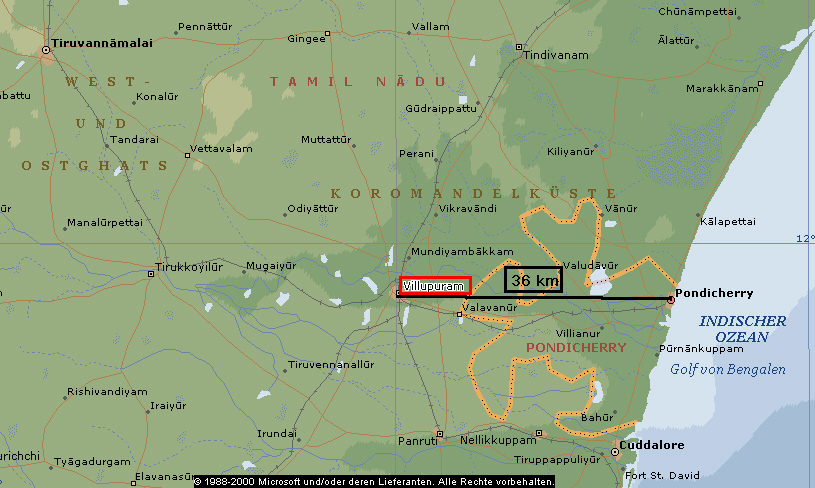
Abb.: Lage von Villupuram (விழுப்புரம்), Tamil Nadu
[©MS Encarta]
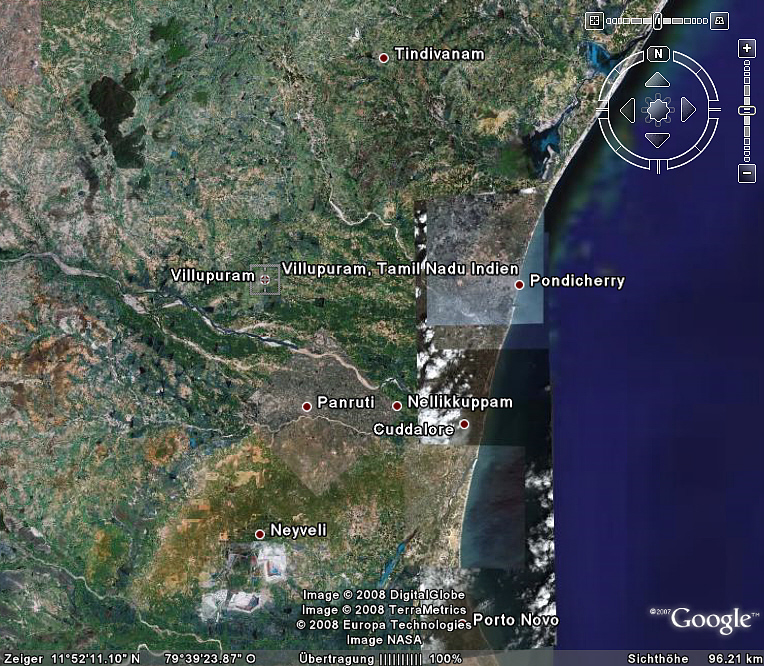
Abb.: Villupuram (விழுப்புரம்) und Umgebung
[Bildquelle: ©Google Earth. -- Zugriff am 2008-03-29]
The route. One hundred miles south of Madras on the main line to Trichinopoly [heute: Tiruchirappalli (திருச்சிராப்பள்ளி)], Madura [heute: Madurai (மதுர)], and the alternative crossings to Ceylon, is the town of Villupuram [விழுப்புரம்], the junction for Pondicherry. Here the [S. 2] railway which has been keeping to the west of French territory turns eastwards to approach the coast at Cuddalore [கடலூர்]; but the high road from Madras [heute: Chennai (சென்னை)], which also passes through Villupuram, keeps its direction a little to the west of south. Eight miles from Villupuram along this road lies Eruvellipet. We left Madras in the early evening, reached Villupuram at night, and went on to Eruvellipet by bullock cart in the early morning.
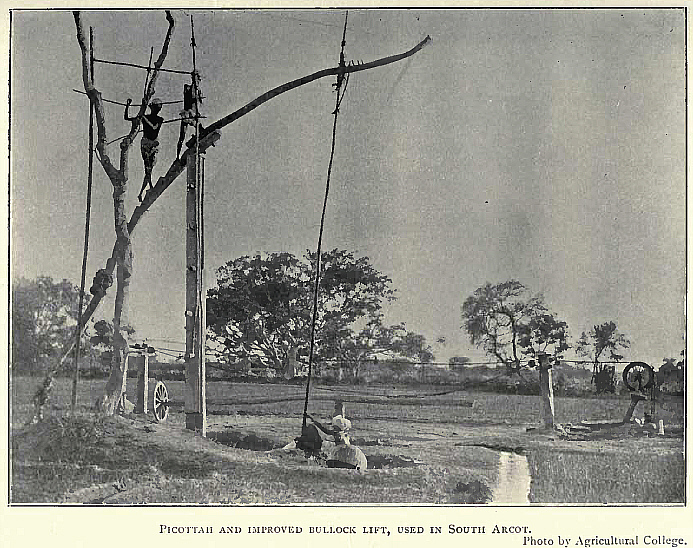
Abb.: Picottah
The country is flat, though the rocky spurs of the Eastern Ghats are visible in the west. The road is a high road in the literal sense, for it has been built up some feet above the level of the surrounding rice fields, which, in the early part of February, were mostly ripening for harvest, though in some spots the harvest had already been carried, and the land was being ploughed for a second crop, and in other places it was still green, and needing water. In the comparative treelessness of the landscape the picottahs stood out conspicuously, with two or three men plodding patiently on the swinging beam that works this primitive pump, alternately towards and away from the wooden pillar, some 15 or 20 feet high, on which it hinges, but always, in either direction, climbing upwards, for the picottah combines the characteristic features of the see-saw and tread-mill.
As is usual with South Indian roads this one has its margin well planted with trees. But whoever was responsible for tree-planting here had views not generally shared by his colleagues in other districts. Though shade was of course the first desideratum, he achieved a secondary object also, instead of the usual banyan or margosa planting coconut palms, mango trees and tamarinds. The right of picking the fruit of these for each mile of road is sold annually by auction, and the proceeds go to the highway fund. This fund apparently needs all the adventitious support it can get, for the road is very bad, in places almost impassable, and, presently when it reaches the bank of the South Pennar river, it presents a hiatus of a mile of sandy track, with, at one spot, a feeble trickle of water just enough to wet the feet of the oxen. A mile or two further on the same phenomenon recurs, where the road crosses the Malattar river, another channel of the South Pennar. Between these two channels, and along the bank of the Malattar, lies Eruvellipet, a village of 1,139 acres and (1911) 1,150 inhabitants.
The River Malattar. Unpromising as the River Malattar appears, an arid waste of sand, with little vegetation beyond prickly-pear, into which cattle, buffaloes, goats and pigs are turned apparently rather for air and exercise than for any nutriment procurable, it is this river that dominates the life of Eruvellipet. It is a river in spite of its appearance ; the water is there, flowing from the tableland of Mysore to the Bay of Bengal, beneath the surface of the sand, and is to be won by digging. Wells in the village if sunk deep enough, are filled by infiltration ; the largest of those wells, equipped with an effective pump driven by an oil-engine, supplies a continuous stream of water for the irrigation of about a dozen acres of technically "dry" land. A more important part of the water-supply comes from the bed of the river, and is brought down by what are known as "spring channels" to the village. These streams supply the water used for drinking and domestic purposes, and irrigate a large part of the "wet lands." Every year, in the monsoon, these channels in the bed of the river are partly obliterated ; [S. 3] every year they have to be dug afresh, by the co-operative labour of the villagers. The fact that this co-operative labour is necessary and that it is certain to bring its reward, goes far to counteract the forces, always so powerful in Indian villages, tending towards industrial apathy and excessive conservatism. Perhaps also the racial constitution of the village helps. Though it is, taken as a whole, a Tamil village, the leading families are Telugu-speaking Reddis [రెడ్డి] immigrants from the north, somewhat taller and larger in frame than the Tamils, lighter and yellower in complexion. The Telugus in their own country are more backward educationally and industrially than the Tamils ; but here, like Danes in Anglo-Saxon villages, as a superior caste, speaking one language in their homes, and another in the village, they are the more apt to make the effort to learn English also, and are in fact frequently trilingual.
Besides the water drawn from the River Malattar, the village has a tank (i.e., an artificial lake) that gives a three months' supply of water for the irrigation of the greater part of the wet land. It is fed by the "Reddi channel," about 15 miles long, starting from the River Pennar, but receiving surface drainage on the way. It is now blocked at the head though not being kept in repair, and at present the tank is fed only by the water that drains into the channel during the monsoons. The repair of this channel is locally considered a desirable improvement. The amount of water received by the tank varies from year to year; but the inconvenience resulting is reduced by the fact that some lands can be watered alternatively from the tank and by spring channels.
Cultivation. Of the total area of the village, 1,139 acres, 722 acres are available for cultivation, 417 acres not. This includes the area of the inhabited village and its two streets, of the tank, of the parts of the river bed and high road within the village boundaries, and of the channels for the distribution of water. Of the 722 cultivable acres 542 acres are officially considered "wet," and pay a kist (land revenue) of Rs. 2,694-11-0 averaging Rs. 4-15-6(6s. 5½d.) per acre; 180 are "dry," and pay Rs. 247-14-0 averaging Rs. 1-6-0 (1s. 10d.} per acre. Where land is let by the immediate holder under Government to a sub-tenant, rents run up to Rs. 40 (£2-13-4) per acre. The use of the land is not strictly according to its official classification. The lands are officially "wet" which can be completely irrigated from the tank and the spring channels ; but "dry" land may be adequately irrigated from a private well, and grow rice, and "wet" land may be used for a "dry" crop. In the year of settlement, 1891, 24 acres of "dry" land were under rice, and 28 acres of wet land under groundnut, spiked millet and ragi, which are "dry" crops.
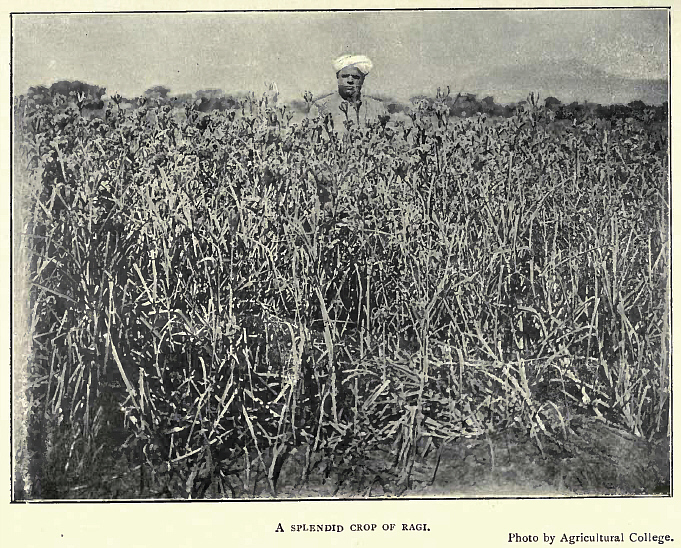
Abb.: Crop of ragi [Eleusine coracana]
In that year only 656 acres out of a maximum possible of 722 were cultivated, as follows:
| ACRES. | |
| Rice |
449 |
| Spiked millet, ragi and Italian millet |
7 |
| Indigo | 44 |
| Groundnut | 19 |
| Vegetables of various sorts | 15 |
| Palmyra and tamarind | 9 |
[S. 49 Since that year, there have been various changes. The total area cultivated has been increased practically to the maximum. Indigo was found unprofitable, and its cultivation entirely abandoned until the effect of the war on the price was realized. In 1916, 25 acres were sown ; with a prospect of a further extension in 1917. On the other hand, the area under groundnuts was much increased, and averaged about 50 acres in recent years. Groundnuts are generally shipped from Madras and Pondicherry for export to Marseilles, and on the outbreak of war, the Eruvellipet growers speedily cut down the acreage to 10 acres. Of the wet land about 13 acres is now under sugarcane. Groundnut (combined with another crop) and sugarcane have this economic characteristic in common, they both are valuable crops, but costly to cultivate.
In Eruvellipet the more common practice is to combine groundnut with kambu (spiked millet) or tenai (Italian millet) on dry lands that depend entirely on rain ; in the case of dry lands that can be watered by wells, a crop of ragi is raised first, and the groundnuts sown just before the ragi is ready for harvesting. The combination of groundnut and ragi yields a maximum gross produce of Rs. 200 per acre. Groundnut, being a leguminous plant, enriches the soil. Sugarcane may yield up to Rs. 500 per acre, though not more than Rs. 400 has been realized in Eruvellipet, but it occupies the ground for a little over twelve months, and should not be grown on the same land more frequently than once in four years. The extension of either of these crops involves an increased local demand for labour. Other crops that have been tried on a small scale and found profitable are tobacco and Cambodia cotton, the Cambodia seed being obtained from the Agricultural department. Gingelly and indigo is considered a good dry land combination ; the gross yield being about Rs. 150 on land dependent on rain, and Rs. 200 where some well water can be applied.
Tree planting and fuel. In two other ways the practical value of the Madras Department of Agriculture to these villagers is exemplified. On the worst land, sandy spots awkwardly placed for irrigation, casuarina, a fir-like tree introduced by the department from Japan, is grown. Casuarina grows very rapidly and is excellent firewood. It is customary to cut it down five, six or seven years after planting.
He who grows casuarina does a service to the whole community because the more firewood is available, the fewer varatties are burnt. Varatties are large handfulls of cow-dung mixed with husks made into round flat cakes and stuck on any convenient rock or wall to dry. To a certain extent they are used in preference to wood, where a slow burning fire is required, as for boiling milk when it is inconvenient to watch it ; but mainly varatties are used because wood is costly or unobtainable. In treeless districts, like much of the Deccan, practically all the cow-dung that is not required for washing the walls and floors of houses, or for surgical dressings for wounds and burns,1 is burnt as fuel. Though the ashes are saved and used as manure, it can hardly be doubted that the loss in fertility from this practice is very great. Even if all the manurial constituents of chemical value remained in the ash [S. 5] (which I presume is not the case) its value in building up humus and improving the texture and power of retaining moisture of the soil, as compared with that of dung, is practically nil. But where wood is abundant by far the greater part of the cow-dung is used for manure. There are even some districts on the West Coast where the women are beginning to object to the duty which ancient custom prescribes for them, of picking up the freshly fallen cow-dung on the high road whenever the opportunity offers, and of carrying it home in big handfulls. As ox-wagons travel in unending streams along the roads on the plains of Southern India, the traveller by road has reason to bless this custom, which keeps the road much cleaner, and makes the dust less noxious, than would otherwise be the case. Nevertheless the sight of women walking with the erect and stately carriage which the practice of carrying burdens on the head confers, reaching down a hand adorned with numerous silver rings and a bracelet apparently of gold (actually gilded lac) to pick up the moist dung, does not readily lose its quaintness.
1 On the antiseptic qualities of urea, and its value for surgical purposes, vide "Lancet," December 1915.
For various reasons the demand for fuel is a growing one. The price of casuarina in Madras was 8d. per hundredweight in 1907, and at the time of writing (February 1917) it is 1s. 2d. per hundredweight. Land under casuarina yields about 5 tons of wood per acre per annum (a casuarina plantation of seven years' growth yields about 35 tons per acre), it requires practically no attention except at the times of planting and felling, and only needs a little irrigation while the trees are very young. The thinnings supply fuel for domestic purposes, and when the trees are cut down, and the roots removed, the land is greatly improved in fertility. Hence a plot of barren land planted with casuarina is a splendid savings bank for a ryot who can foresee a period of heavy expense in six or seven years' time ; as, the marriage of a daughter, or the education of a son at the University.
Single transplantation. The village of Eruvellipet has generally adopted the system of "single transplantation" of paddy recommended by the Agricultural department. All except the poorest and laziest cultivators of rice in the Madras Presidency sow the paddy on comparatively small spots, and transplant it thirty to forty days after sowing. But the customary method in transplanting is to put several plants together into one hole in the levelled mud of the rice field. Experiment has proved that if each seedling is separately planted and all are evenly spaced, there is a considerable saving of seed and a heavier crop. The new method is spreading, but as yet very slowly. Unless the grains are sown thinly in the seed-bed, single transplantation takes more time and labour, and if this is not realized, disappointment follows. The poor ryot, moreover, naturally and properly, refuses to experiment, as he cannot afford a failure, and waits to see with his own eyes that a new method is an improvement before he adopts it. Richer ryots, who can afford to experiment, also can afford to employ hired labour, and they find the coolies whom they employ will not change their methods unless compelled to do so by strict supervision. They want to do their work in the semi-automatic manner attained by unchanging habit, and not to tax their brains and think about what they are doing.
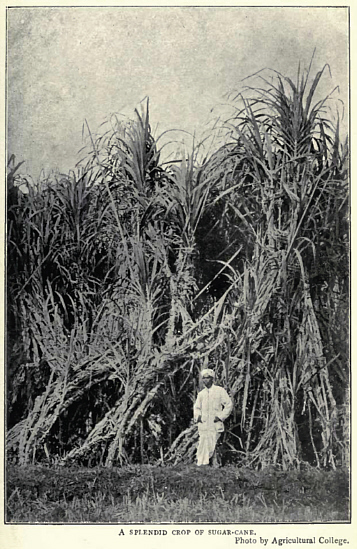
Abb.: A splendeed crop of sugar-cane.
[S. 6] Sugar refining. The enterprising spirit, however, has its dangers. In 1885 (cir.) two brothers, well-to-do ryots in Eruvellipet, took a leading part with others in the erection of a sugar refinery. They were disappointed in their hope of obtaining a licence for the distillation of arrack, which would have been a profitable by-product ; and there was another mill in a village five miles distant which competed for cane. The result was that in 1895 the Eruvellipet company was wound up,1 and the mill fell into ruins. One of its two tall chimneys still rears its head, but the other has been pulled down to supply bricks for other buildings, and the two brothers above mentioned having died, left their families encumbered by debt. What followed is rather curious, and throws some light on the economics of the Hindu family system. The dead men had held jointly a holding of 102 acres. One of them left one son, the other four. It was resolved by these first cousins to divide the property, so that each might struggle with his own debts. By law there should first have been an equal division of the holding into halves for the two families, and then the family of four brothers should have equally divided their half among themselves. On the other hand if the ancient law of Welsh gavelkind, which may be regarded as springing from the sense of justice of a people under the patriarchal system, had been applied, there would have been an equal division among the five first cousins. Actually there was a sort of compromise between these two principles. The land was divided into six equal parts, of which the only son took two, thus getting one-third of the whole instead of his legal share of a half, and the four brothers took one part each, thus getting one-sixth each, instead of one-eighth. He who had the larger share was able to clear off his debts ; but the four brothers, each with holdings of about seventeen acres, and debts of some thousands of rupees at not less than 18 per cent interest, had a much harder struggle. The most business-like way to deal with such a situation is for the ryot who is so placed to face it immediately and sell enough land to pay off his creditors, as even in the case of a forced sale land will fetch sixteen years' purchase of its annual value and upwards. It is obviously bad business to pay 18 per cent on borrowed money in order to avoid realizing property that only yields 6 per cent. But the land hunger of the Indian peasant is comparable in intensity, being no doubt similar in its psychological basis, to his craving for jewellery. He will buy land recklessly when he gets an opportunity, but he will not sell unless he is absolutely compelled. There are other resources. An unmarried landed proprietor, owning (under Government) seventeen acres, mostly "wet," may hope for a handsome dowry with his wife. His sons may, if he manages to give them an English education, secure a Government appointment, and even, though this is a remote possibility, achieve the magic letters "B.A., B.L." and become vakils. And if one member of the family succeeds in so establishing himself, all the others benefit. Family solidarity in India is a great fact, most important both for good and evil. It is family solidarity that in a country of widespread poverty copes with destitution so effectively as to preclude [S. 7] a poor law, and to preclude also the formation of the custom of the whip round among workmen for a mate in misfortune from which the British Friendly Societies and Trade Unions developed.
1 Sugarcane crushing is still carried on, the oil-engine mentioned above drives the mill.
What the "family" means in India may be judged from the following dialogue. I noticed that a friend referred to a fellow caste man, Mr. A.B., as his uncle, but hesitated a little in using the word. So I asked "How is he your uncle, is he an uncle by blood, or by marriage ?" He replied, ''He is not exactly my uncle. He is related to me this way. My mother's brother was C.D. C.D.'s uncle's son on his father's side was E.F. E.F.'s daughter married A.B.'s sister's son." I commented "That is not a very close relationship." He replied "There is another way in which he is related to me. He married a girl whose sister, G.H., had been married to K.L. G.H. died, and K.L. married subsequently the daughter of the sister of my father's sister's husband." When such meanings as these are attached to the word "uncle," the meaning of "nepotism" in India may be guessed.
A typical holding. Such a holding as that referred to will consist of a number of small plots of land scattered over the area of the "village" in its wider sense; while all the habitations of the people are congregated together in two spots, which may be termed, respectively, the caste village and the pariah village. The following are the exact measurements of a typical holding of the larger size at the time of the last settlement, 1891, in acres and decimals of an acre:
1.49, 1.87, 2.31, 6.88, 1.55, 0.83, 1.65, 2.24, 1.44, 1.38, 2.47, 0.41, 0.39, 0.30, 0.32, 0.09, 0.13, 0.28, 0'20, 0.96, 2.51, total 29.70 acres in twenty-one parcels.
The distribution of land in different holdings, therefore, resembles that in English villages containing numerous small holdings in the open field districts before enclosure. There is, however, a marked difference in the shape of the different plots, which, instead of being, as in England, long narrow rectangles, approximate to squares. Each plot of wet land is surrounded by a little embankment, about a foot broad and about a foot high, to keep in or exclude the water, which is turned on or off by temporary openings in the embankment according to the requirements of the crop. These embankments also serve as paths for men and cattle.
Some of the holdings in 1891 were "joint pattas" some "single pattas." The following table gives an idea as to how these were held :
| proprietors | holding(s) of | plots. |
|---|---|---|
| 5 | 1 | 21 |
| 5 | 1 | 3 |
| 4 | 2 | 11 |
| 4 | 1 | 9 |
| 4 | 1 | 7 |
| 4 | 1 | 3 |
| 4 | 2 | 1 |
| 3 | 1 | 30 |
| 3 | 1 | 13 |
| 3 | 1 | 4 |
| 3 | 1 | 2 |
| 3 | 5 | 1 |
| 2 | 1 | 16 |
| 2 | 1 | 10 |
| 2 | 1 | 9 |
| 2 | 1 | 5 |
| 2 | 2 | 2 |
| 2 | 5 | 1 |
[S. 8.]
| plots | |
|---|---|
| 1 | 112 |
| 1 | 36 |
| 1 | 35 |
| 2 | 24 |
| 1 | 16 |
| 1 | 13 |
| 2 | 10 |
| 2 | 9 |
| 4 | 8 |
| 1 | 7 |
| 1 | 6 |
| 3 | 5 |
| 4 | 4 |
| 6 | 3 |
| 8 | 2 |
| 32 | 1 |
The average area of each plot was just over one acre; and the 656 acres of cultivated land were shared by no less than 165 ryots, which allows a little less than 4 acres for each ryot on the average. This is according to the official survey. At the present day the ownership of land is much more concentrated. The largest of these holdings, that of 112 plots, and another of 24 plots were, in 1891, held by brothers, one of whom was childless, and they both passed to the only son of the other brother. The larger property thus created has been steadily increased by the purchase of more land from small ryots who, unable to make headway against debt, have sold their land and, in some cases, emigrated to Ceylon. Altogether this relatively wealthy man at the time of my visit owned about 400 acres in the village, and about 200 acres in adjoining villages. He cultivated about 200 acres himself, and let out the remainder to tenants. What is let is let to small holders who cultivate by their own labour. The large farm which he keeps in hand he cultivates by the help of 40 "padials."
Padials.—A "padial" is a sort of serf, who has fallen into hereditary dependence on a landowner by debt. In almost every case the original debt was a sum of money borrowed by a landless man to solemnize his marriage or, more frequently, that of a son or daughter, the borrower undertaking to work for the lender, until the debt should be repaid, in return for a certain limited supply of food. Quite recently a lad of 18 borrowed Rs. 25 in cash and grain to celebrate his wedding with due festivity and became a padial. Such a loan never is repaid, but descends from one generation to another; and the padials themselves are transferred with the creditor's land when he sells it or dies. One proprietor informed me that he paid his padials 30 Madras measures of paddy per month per head. At present prices 30 Madras measures of paddy are worth about Rs. 3-12-0 (5s.). A Madras measure of paddy weighs 2½ lb., but when husked loses about half its volume and one-third of its weight. The padial's paddy allowance therefore [S. 9] works out at about 27 oz.1 of raw rice per day ; a quantity that the man is probably able and willing to eat himself without assistance from his wife and family. Another landowner gives his padials 22 Madras measures of paddy per month, a daily meal of ragi porridge, and annually two cloths and 18 measures of paddy or some other grain. The family of the padial must help the patron when required, but then extra payment is made. Padials are sometimes required to work with two intervals from 4-30 a.m. to 6 p.m. ; but the regular hours of labour are 6 a.m. to 6 p.m.
1 The gaol allowance for a man doing hard labour is 25 oz. of ragi flour, rice and pulse combined, 6 oz. of vegetables, ½ oz. of oil, and 2 oz. of various condiments, per day.
The one way of escape for the padial from this condition of servitude and poverty is emigration. At Villupuram there are offices of the "Ceylon Labour Commission," which recruits labour for the Ceylon plantations. Their economic condition in Ceylon is vastly improved, and they have opportunities of saving money, and, if they choose, of returning to their native districts and buying land. Needless to say the emigration of padials is discouraged by their creditors. It is impressed upon the padial that it is a point of honour for him never to leave his master ; and he is given to understand that he cannot legally do so. In some districts the creditors adopt the device of making the padial sign a fresh document every few years, so that in a court of law it may be made to appear that a fresh debt has been incurred.
Emigration to Ceylon is not on the indenture system, and the emigrant's contract with the planter who employs him is terminable by a month's notice on either side at any time; nevertheless there are some signs that the agitation against indentured emigration to Fiji and other places may be widened so as to check the flow of emigrants to Ceylon.
Debt is an almost universal condition. Landowners and cultivators, large and small, are in debt to one another and to Chettis (a merchant caste) in Villupuram. In some cases the debts are temporary, contracted afresh every year and liquidated when the crop is sold ; in other cases they are permanent, either because the debtor cannot pay, or because he prefers to go on buying land with borrowed money or incurring other capital expenditure, to paying off what he owes. The rate of interest may be 24 or 36 per cent, i.e., 2 or 3 per cent per month. It is noteworthy that in many cases the ryots consider it worth while to hold up their crops for a while after harvesting, expecting the rise in price to more than counterbalance the extra interest. One man was pointed out to me as an exception to the general rule of indebtedness a man who lives on his earnings and within his income. He is a dhobi (washerman) and is said to have over 1,000 rupees saved.
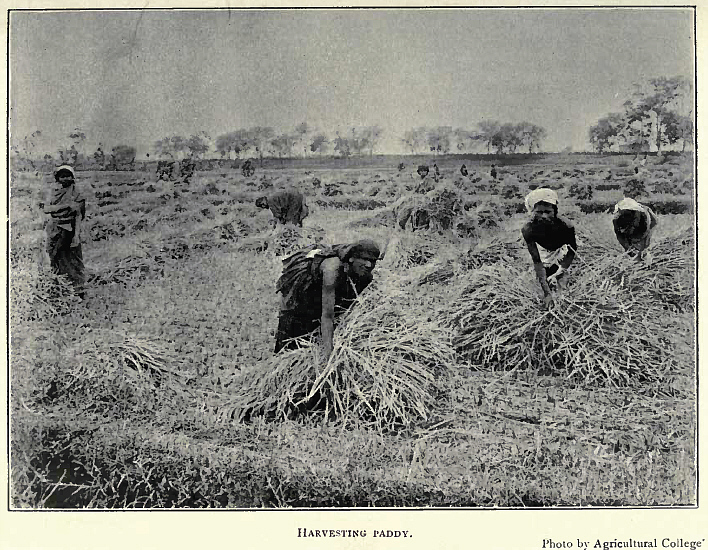
Abb.: Harvesting paddy
The efficiency of labour. If labour is extraordinarily ill-paid in South India, it also appears to be extraordinarily inefficient. At Eruvellipet I saw both ploughing and reaping. The reaping in particular is an extraordinary sight. A number of men, clad in loin-cloths only, squat in the field that is ripe for harvesting. At that time the rice stalks no longer stand upright, but are laid before the wind. Work begins at the windward edge. Each man [S. 10] has a sickle, about the size and shape of a small bill-hook, but with a serrated edge. He squats on the ground on his heels, holds the stalks that grow from a single root in his left hand, severs them close to the ground with a blow from the sickle in his right hand, then gently deposits the bundle of cut stalks on one side. Then, still squatting, he shifts his position by an inch or two, and similarly deals with the next root. In the course of a day eight men may cut an acre.1 Tn other districts it is the custom for women to cut the corn, and, in Mysore, I was informed, it took fifteen women to cut an acre in a day. But in Eruvellipet the women carry the corn. They collect it into bundles, carry these on their heads along the earth embankments mentioned above to the nearest village threshing-floor which is a small plot of land elevated sufficiently above the level of the paddy fields to keep dry. A man there receives the bundles, shakes out the loose grain, and tosses the straw on to a heap to be subsequently trodden on by oxen to recover the remainder. The rice afterwards has to be husked, by being pounded on the pestle and mortar system. The easier method of doing this is to boil the grain, and dry it in the sun first ; but for Brahman consumption the grain is husked without boiling.
1 "Six to ten men, or ten to twelve women will reap the crop. Bundling and carrying to the floor close by, two men and four women. Stacking, if done preparatory to threshing, one man per acre." R. C. Wood, "Notebook of Agricultural Facts and Figures, p. 35."
The village munsif was ploughing a plot of between one or two acres. He had sixteen plough teams on the job : twelve were at work, four resting. Each plough team was a pair of feeble oxen or of feeble buffaloes, which crawled through the liquid mud, dragging the light wooden ploughs behind them. The treading of the mud by the oxen is as important a part of the preparation of the land as the churning of it up by the plough. It is considered that stronger and heavier beasts would sink too deep in the mud.
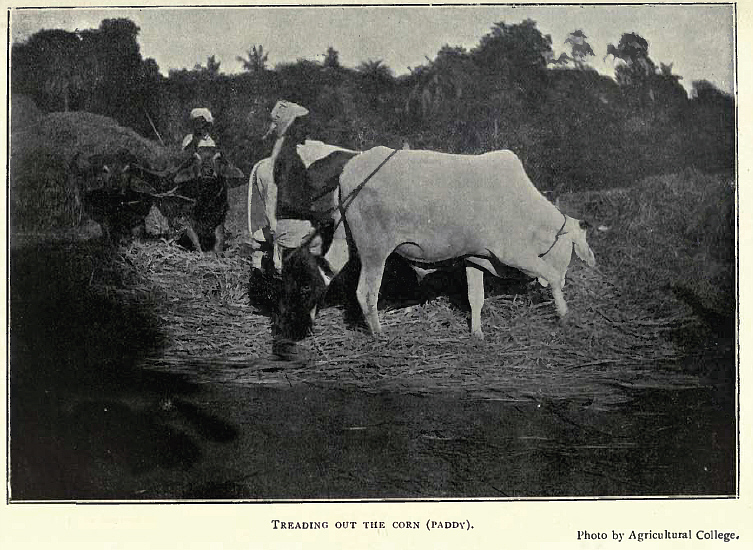
Abb.: Treading out the corn (paddy).
Cattle. The village has about 250 working cattle, which works out at about 5% acres per plough team, and that means that it is rather short of cattle. As a general rule it is considered that four acres of wet land to a pair of bullocks is the right proportion. Ploughing must be done when the water is available. Eruvellipet, however, with its tank and spring channels, can extend its ploughing season over a longer period than many villages, and can therefore manage with fewer oxen.
Besides the working cattle, the village had about 150 cows and she-buffaloes, and about 180 young animals of these species. Not enough young cattle are raised in the village to maintain the supply of beasts for the plough and for cartage to Villupuram, and the stock is continually renewed by purchase. The imported bulls and bullocks come from Mysore, and are superior to those reared in the village. The supply of milk from the cows is very small. Besides calves and milk, the Indian cow produces manure or fuel, hides and bones ; for the sake of these commodities, and to avoid the sin of cow-killing, vast numbers of animals are doomed to drag out a miserable semi-starved existence. In Eruvellipet the dung which the village herd of cows and young stock leaves in the bed [S. 11] of the river is the perquisite of the village potter, who has the special right to collect it for fuel. Goats and pigs are also kept ; and one or two donkeys, the property of the dhobis. The goats number about 100 ; they are valued chiefly for manure : only the low caste people will drink goats' milk.
The caste village. To a great extent the village is self-supporting. The various sorts of habitations in the caste village and pariah village are made almost entirely out of local materials by local labour. Bricks and tiles are made. There are carpenters, blacksmiths, goldsmiths, schoolmasters and priests ; a post office in the charge of the headmaster of the school, and two oil-mills, besides the sugar mill worked by the oil-engine mentioned above. Agricultural implements and carts are made by the village carpenters out of local timber. There is no weaving done in the village, but there is a weaving village a few miles away. Palmyra trees supply toddy and jaggery. Religious festivals satisfy the more imperative spiritual cravings.
Even in this small, almost self-contained, Dravidian community we find two civilizations, both apparently of vast antiquity, existing side by side, and though each for innumerable generations has acted and reacted upon the other, they still remain distinct. On the west side of the high road is the caste village, open, exposed to the sun. One house in it is imposing, with two stories, a flat roof, a covered approach, ornamental iron gates and pillars adorned with paintings. The two parallel streets, running east and west, and connected at the west end by a cross street, are maintained in a fit condition for cart traffic. The houses, some built of brick, some of earth, some tiled, some thatched, have the little pial, or verandah, facing the street, with niches in the walls for lights to burn at nightfall. Built round little courts which are open to the sky, they give seclusion to those who desire it ; and, though there are no Muhammadans and no purdah in the village, the women habitually stay very much indoors. At the eastern end of the village, adjoining the high road, are two temples to Siva one a temporary building which the god is inhabiting, till the other, the new temple, is finished. Here also are the sacred cars in which deities are joyfully conducted round the village during certain festivals, and a great stone lingam, the symbol of the function of generation, and therefore of life. At the west end is a temple of Ganesa, the elephant-headed "belly-god," the god of prosperity, son of Siva. There are two cars, one for Ganesa, used on his birthday, the festival of Vinayaga Chaturti; the other for Ponniamman (Kali) on Tirunal, a ten days' festival in May.
The Pariah village. To the east of the high road is the pariah village, with its own architecture and its own temples. It has no streets, only paths worn smooth by the pressure of bare feet. It lies altogether in the shade, in a grove of palms mixed with trees of various kinds. Houses are made of a framework of sticks, the roofs thatched with palm leaves, and the walls also woven, as it were, of leaves and twigs. These dwellings are dark inside, but with sufficient openings to keep well ventilated. The floor is bare earth. There is little privacy here. Men, women and children live in the open air. The one substantial building is a new temple, built at a cost of 300 rupees by the pariahs out of their own funds, [S. 12] to Desamma or Mariyattal, the goddess of small-pox. There is also an open air shrine of Aynar, or Ayanar, who is carved in stone squatting between his two wives Purni and Pushkali, all three being naked except for ornaments and head dress. The two goddesses wear tall sugar loaf erections on their heads somewhat similar to those on Assyrian statues ; but the god one of a very different type. There is a Puranic story to the effect that Aynar is the offspring of Vishnu and Siva, Vishnu having temporarily assumed the form of a woman ; but it may reasonably be assumed that the cult of Aynar, which is very widely spread in South India, had originally no connection with either that of Vishnu or Siva. The stone on which these images are carved in rather deep relief stands about 10 inches high, and is about 2 feet long. Yet, another shrine, in the form of a sacred margosa tree, the leaves of which are used as a poultice for small-pox, stands in the high road between the two hamlets. As is usual the space in front of the image of Aynar is surrounded with clay figures of horses, whereon the god rides round the village at night, guarding it from evil spirits.
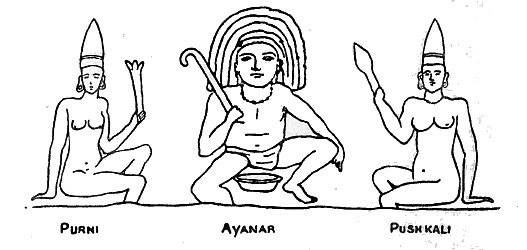
Abb.: Purni, Ayanar, Pushkali
Before leaving these village deities it may be worth while to mention that across the river worship is paid to a carved stone figure representing a mythical landed proprietor, whose fields were tilled for him through the night by Kali and her six sisters. One night they took a holiday, and the ungrateful man reviled them next day for idleness. The goddesses promptly killed him for his ingratitude ; and in consequence, by a psychological process which I do not understand, he himself became divine, and his image, which juts out amid the sand and prickly-pear of the river bank, is black with ghee. Beside him the goddess Kali herself, represented by a small stone with three red spots on it, presents a very insignificant appearance. Pariahs, like Brahmans, and upper-caste Hindus generally, burn their dead ; but priests of village deities, together with carpenters, blacksmiths, and goldsmiths, bury.
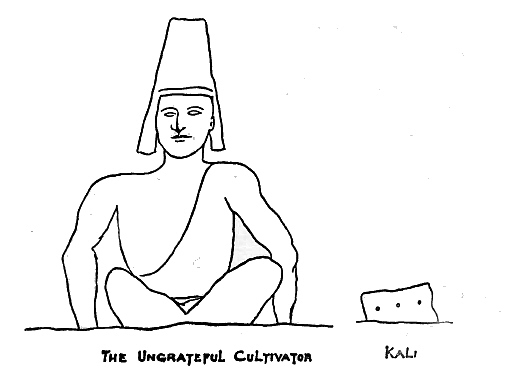
Abb.: The ungrateful cultivator. Kali.
Sanitation. Statistics of births and deaths are recorded in the village, and I found the figures for the three years, 1912, 1913, 1914, available. It appears that actual births and deaths are recorded [S. 13] accurately, though this is far from being the case in all villages. In those three years there were 122 births, an average birth-rate of 35.4, and 93 deaths, giving a death-rate of 27.0. Of the recorded causes of death cholera accounts for 22, small-pox for 1, "fevers" for 35, "other causes" for 38. The high proportion of deaths from cholera seems to be associated with two articles of sanitary faith firmly held in the village,
that the water derived from the river bed by spring channels is perfectly safe and pure, and can be drunk unboiled ;
that the most fitting and seemly solution of one sanitary question is to use the river bed as a latrine.
It is probable that both these beliefs are held by other villages on the banks of the river, above and below, and if so, the prevalence of cholera right along its course is easily understood. It goes without saying that the dhobis take the dirty clothes of the village to the spring channels to wash them there by the process of alternately sousing them in the stream and battering stones with them ; and that the people who will drink the water further down make no protest.
The school has 67 boys and 7 girls on the rolls, a few of whom come from outside the village. The children are graded in five standards. The headmaster takes standards III and IV ; his two assistants, both men, take standards II and III, and the infants, respectively. The villagers' petitions entrusted to me for conveyance to Government were
for an English school, and
from the pariahs, for a new well.
The common fund. In spite of the social and religious severance between pariah and caste-man, and the economic severance between land-owner and padial, the general impression made on [S. 14] my mind during my four days in Eruvellipet, was that of a spirit of local solidarity. I heard no mention of what is so frequent, the division of the village into two hostile factions. It was said that the munsif was able to deal with such disputes as occurred. There seemed to be no trouble about the administration of the common fund of the village, the very existence of which is a testimony to the existence of this village solidarity. It is derived partly from the sale of an exclusive right to catch fish in the tank to one villager, and of that to cut reeds, which grow extensively in the tank, and which are valued for thatching, to another. But the greater part comes in another way. I have previously said that the right of gathering fruit from the trees along the high road is sold, in mile sections, annually by auction. The Eruvellipet villagers do not compete with one another at these auctions. They send one representative who buys the fruit on two miles of road which lie mainly, but not entirely, within the village boundaries. Then they have a subsequent auction among themselves, and prices about ten times as high are ordinarily realized. The profit amounts to about 200 rupees per annum. The village fund is used to promote the economic well-being of the village, by religious ceremonies which secure favourable seasons, and by presents bestowed where the giving of presents is deemed a profitable investment.
In some respects the village of Eruvellipet is fairly typical of predominantly "wet" villages in the plains to the south of Madras. In other respects it is exceptional. Unfortunately, in its economic and sanitary weaknesses and defects, in the padial system, the general indebtedness, the bad management of cattle, the prevalence of cholera, it is far more representative than in the enterprise and initiative it displays and its power of combined action.
The population problem. It will be noted that the density of population in the purely agricultural village of Eruvellipet is no less than 650 per square mile of land of any description, cultivable or otherwise. This immediately provokes the question whether local over-population is not threatening, or already present. There is a natural increase of population, by excess of births over deaths, of ten per annum. If cholera and other preventible diseases were dealt with the natural increase would be greater ; for it is difficult to conceive a reduction in the birth-rate corresponding to the possible reduction in the death-rate. Indian families are seldom very large. The period of child-bearing is shorter than in Europe, as, though it begins earlier, it also ends earlier. Occasionally a girl will be a mother when only twelve years old ; but very rarely will a woman bear children when past thirty-five, and the average period of fertility can be put at a duration of twenty years. A baby is first fed with other food (rice) in addition to his mother's milk at the age of six months, but the mother continues to suckle him for about two years longer ; and the ordinary interval between successive births is three years. Hence the Indian birth-rate per thousand married women is low ; it is the fact that all girls are married, almost without exception, either before or immediately after puberty, and that husbands and wives, again almost without exception, are keenly desirous of having children, that causes the birth-rate per thousand [S. 15] living, to be so steadily maintained at a very high figure. This attitude of mind is extremely deeply rooted ; and while it is, of course, subject to change, such change is sure to be very slow. We are not likely to see any alteration in Indian feelings with regard to marriage and parentage sufficient to diminish the birth-rate appreciably during the next hundred years. On the other hand reduction of the death-rate is immediately possible, and is, in fact, a work which is already in hand, and likely to go forward with rapid acceleration.
Under a steady increase of population an agricultural village has three resources:
an extension of the cultivated area,
an intensification of cultivation,
migration to less thickly populated areas, or to manufacturing districts ; and,
in some cases, the possibility of ceasing to be purely agricultural, by developing local manufactures or handicrafts.
In Eruvellipet, as has been stated above, the extension of the cultivated area has reached very nearly the maximum possible. Intensification of cultivation also has already reached a very high point, though it is impossible to put any limits to further possibilities.1 One effort to create a local manufacture has been made and has failed. Existing handicrafts cater for most of the village demands, and a neighbouring village weaves the coarse country cloths worn by the bulk of the people, and no idea either of extending existing handicrafts or introducing new ones appears to have occurred to any one. For the present, therefore, the natural increase of population tends to be balanced by emigration.
1 For example, if the Reddi channel above mentioned were cleared, so as to bring the flood water in the Pennar river into the tanks dependent on it, all or nearly all the Eruvellipet wet lands could grow two crops, and the silt would add to the fertility of the land.
Emigrants' earnings. The emigration from Eruvellipet and the surrounding district appears to be entirely to Ceylon. There is an office of the Ceylon Labour Commission in Villupuram which does a pretty active business. Money for the passage is advanced to coolies, and they subsequently pay off their debt out of their earnings. On the tea and rubber estates they are housed by the planters, and supplied with rice and other necessaries, and at the end of the month receive in cash the balance of their earnings over the amounts they have drawn. They work in groups under a "kangani," .who is both a foreman and recruiter, and who is paid, in addition to his own earnings, a small commission on the earnings of the gang. I am indebted to Mr. N. H. M. Bowden of Trichinopoly for the following statement of the earnings of such a family group during four months, on a Ceylon rubber estate. It will be noticed that all the members of the gang are related to the kangani, and that there are in all eight men or lads and four women, besides some young children who do not earn and whose names do not appear. It has to be remembered, on the one hand, that the money wages stated are in addition to maintenance, and, on the other, that the four months are, on the whole, the most favourable in the year. In the driest months the flow of latex diminishes, and in the monsoons the rain interferes with the work of collection.
[S. 16]
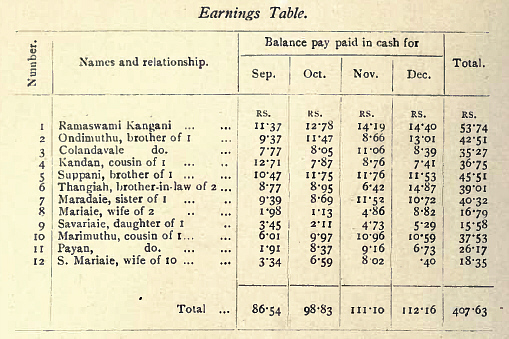
Abb.: Earnings Table
Mr. Bowden assures me that this can be taken as fairly typical. Even if these earnings be above the average, it is clear that emigration to Ceylon opens out possibilities of very considerable economic advantage to the landless labourer or peasant with a very small holding and a large family. Indian emigration is a subject of keen controversy and fiery agitation; but the problem is not to be solved by merely keeping the coolie in his native village. One is glad to see that this fact is recognized by the Editor of "The Indian Emigrant."
Indian poverty.—To draw conclusions with regard to the broad economic conditions of life in India from a single village would be foolish; but even a single village may suggest far-reaching hypotheses, which it is worth while to state with a view to subsequent correction or verification.
India was famous for centuries for its wealth. Recent writers, from Lord Macaulay onwards, assure us that India is extremely poor. The official estimate of the average income per head of the whole Indian population in 1898 was only £2, though that was, very probably, an underestimate at the time, and would have to be very considerably raised now. My own estimate for the average income per head in the Madras Presidency in 1916-17 is not less than Rs. 72, i.e., nearly £5. Eruvellipet suggests that, at any rate so far as the Carnatic plain is concerned, the truth is that India is a very rich country, inhabited by very poor people. The real wealth of any country consists mainly in sunshine, either sunshine received directly from year to year, or stored in the form of coal or oil. True, sunshine is valueless without rain, but Southern India has, over the greater part of its area, as a rule an excellent rainfall, though liable sometimes to be deficient, sometimes excessive. Our English arable land will bear a crop of wheat once in four years; the paddy field of the Carnatic bears one. two, and sometimes three crops of rice every year. Other crops are [S. 17] produced in immense variety and many of these are extremely productive and profitable.
But if the land is extraordinarily productive, labour is extraordinarily unproductive. From a comparison of results in reaping and ploughing it might be estimated, roughly that a week's work by a ryot or coolie in the Madras Presidency is about equal to a day's work by a British agricultural labourer, if unaided by machinery. As in the Madras Presidency, on one crop land the agriculturist works for only about five months in the year, and on two crop land only for about eight months, it would follow that, on the average, the Indian agriculturist during a year does only what would on British standards be one month's work.1 This comparison is not quite fair to the Indian worker, as he would doubtless be more expeditious over ploughing and reaping if it were necessary, but the fact remains that the Indian worker earns very low wages, has a very low standard of expenditure, and attains a very low level of efficiency, and these three characteristics of Indian life are so inter-connected, that it is impossible to say which is cause rather than effect. Indian employers do not believe in the Economy of High Wages ; and as yet only faint beginnings of trade unionism are to be found among Indian manual workers. Nor does Indian popular religion, which fosters submission, nor popular philosophy, which inculcates the art of abstinence, encourage a revolt against the prevailing conditions. Family solidarity, involving as it does the interdependence of each individual with a large circle of relatives, is not conducive to strenuous individual effort. In fact various strands of economic, social and religious conditions and customs are strangely and deftly interwoven in the web of South Indian life, and low wages, low efficiency, and high abstinence are the ground plan of the pattern.
1 Some Indian workers attain a much higher degree of efficiency. For instance there is a caste of navvies in Madras, called Ubravars or Oddars, immigrants from the north, famous as good workers. They work in sets, each set consisting of one man and one woman. Mr. J. W. Madeley, Special Engineer, Madras Corporation, who employs these Ubravars very largely, estimates that three sets will do as much work in a day as two English navvies. Reckoning a woman equal to half a man, this makes the proportion of efficiency I : 2¼. The same proportion is found to hold between the weavers in the Buckingham and Carnatic Cotton Mills in Madras, and Lancashire weavers. These mills are extremely well organized and use only up-to-date machinery. Boys (half timers), in the spinning sheds, are said to be little, if at all, inferior to their Lancashire rivals. In North India the cases of high efficiency of labour are more numerous than in Madras.
The next villages I had the opportunity of investigating personally were in the neighbourhood of Salem, a town of considerable importance on the railway that runs from Madras [heute: Chennai (சென்னை)] to the West Coast through the Palghat [പാലക്കാട്] gap between the Nilgiri [நீலகிரி] and Palni ranges. Salem carries on a considerable trade in grain and cotton cloth ; it has an extensive weaving quarter and other quarters devoted to cart building and bamboo mat-making. The bamboos are cut on the slopes of the Shevaroys [heute: Selvarayan], which form a table land, the top of which is occupied by coffee plantations with the little hill station of Yercaud [ஏற்காடு]. Lower hills, mostly very steep and rocky, almost surround the town ; one of them being Kanjamalai, which [S. 18] largely consists of iron ores of varying qualities. From Kanjamalai came the material of the Menai Tubular Bridge, built during the period (1829 67) during which Josiah Heath and his successors were carrying on the attempt to establish a great steel industry on the basis of the Kanjamalai ores and charcoal from the neighbouring forests a splendid failure, In Salem the chief memorial of the work of the Heath Companies is the ruin of most of the local forests. In an "unreserved" forest, i.e., one that is not protected by the Forest Department, there is in any case a struggle between natural recuperation and the destructiveness of the peasants, who require the foliage of the forest for green manure, and are reckless in their manner of collecting it. The balance was upset when wholesale felling for charcoal was resorted to ; and when the villagers turned on their goats the ruin was completed. Rocks, prickly-pear, and euphorbia alone remain, except where there are sacred trees or groves. Many of the reserved forests in the neighbourhood are in little better case. They are protected by a few granite posts with the letters "R.F.," and by forest guards, one man to a vast extent of country, and this protection is not always adequate.
Hence in the neighbourhood of Salem the problems connected with the inter-relation between agriculture and forestry are specially urgent. Throughout most parts of South India there is little pasture except common pasture. Working cattle are mainly fed upon straw, and cotton seed in the cotton growing districts ; cows generally have to struggle for a scanty living. If they produce but little milk, they yield dung when alive, and bones and hides when they die of disease or starvation. The tendency to overstock, which is general in all countries where pasture is held in common, is specially rampant in South India, where the co-operative spirit and power of organization are specially weak. The improvement of the quality of the cattle is one of the most important lines of advance open to Indian agriculture, and this is as much a question of the improvement of the methods of feeding and the growing of fodder, as of improvement of breeds. Every attempt on the part of Government to protect forests where they are being destroyed is bitterly resented by the neighbouring villages which are accustomed to use these forests as pasture. As long as the forest areas, or other common grazings are available, improvement in methods of feeding are not likely to be adopted. Similarly, it is in most cases much more profitable to grow for green manure leguminous or other crops specially rich in nitrogen, than to gather it from the forest, but as long as the peasant can get green manure, of a sort, which grows wild, he is not to be convinced of this.
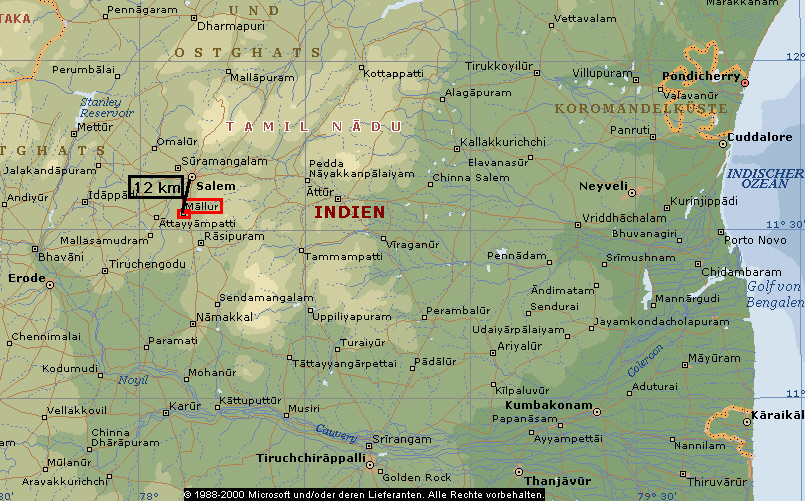
Abb.: Lage von Mallur [மல்லூர்],
Tamil Nadu
(©MS Encarta)
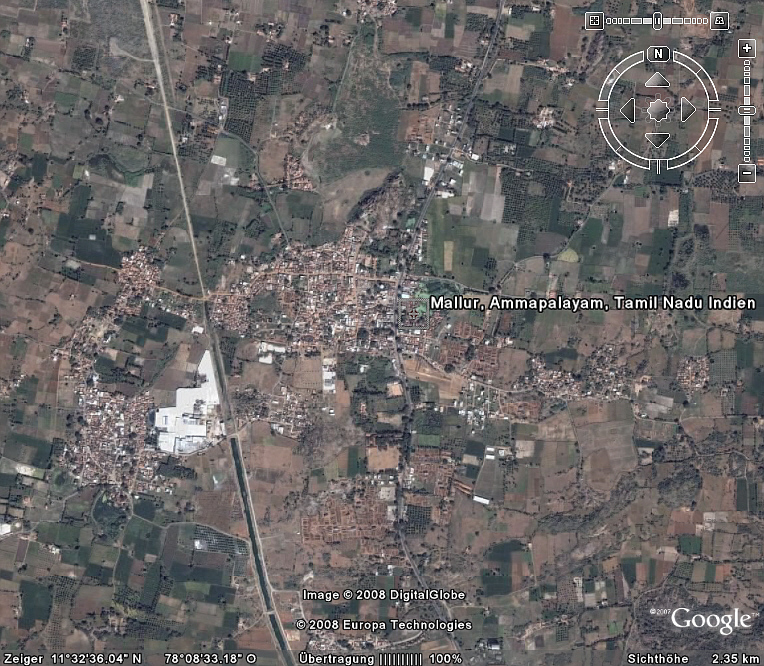
Abb.: Mallur [மல்லூர்], Tamil Nadu
[Bildquelle: ©Google Earth. -- Zugriff am 2008-03-29]
The village of Mallur [மல்லூர்] was selected for me by the Collector, Mr. E. W. Legh, as a typical dry village of the Salem district. It is even more thickly inhabited than Eruvellipet. With a cultivated area (not capable of appreciable extension) of 750 acres only, it has 2,042 inhabitants. The whole village speaks Tamil, and the leading inhabitants are Vellalas, an important cultivating caste, though there are trading and artisan crafts in considerable numbers. The pariahs number 427. There are 16 [S. 19] families of weavers, working mostly with common country looms, though two or three use the fly shuttle, weaving coarse cloths for the Salem market, and earning about five annas per day per loom. Weaving, at the time of my visit, was doubly depressed, firstly by the shortage of dyes and consequently of dyed yarn, and secondly by the fact that plague was raging in Salem, and the market was in consequence somewhat disorganized. The earnings of a weaver were, at that time, scarcely better than those of an agricultural labourer, which also averaged about 5 annas per day. This, so far as my experience goes, is unusual. Elsewhere I have generally found that weavers earn more than agricultural labourers, and this is one of the most striking witnesses to the remarkable vitality of hand-loom weaving in India. It is characteristic that the weaver does not combine his craft with agricultural work.
In addition to the weavers there are in Mallur ten potter families, and masons, blacksmiths, goldsmiths and carpenters, together numbering fifteen or sixteen households. There is a weekly "sandai" or market on a rocky open space adjoining the high road to Salem, at which the products of the village manufacture, together with an immense variety of other goods, are sold.
Mallur tank. The rainfall in the Salem district is very variable. There has very recently been constructed a great reservoir, the Panamarattuppatti tank, by the construction of an embankment across the outlet of a mountain valley, for the sake of the water-supply of the town. It so happened that the period of construction was marked by a succession of seasons of deficient rainfall. The people of Mallur suffered. They have a tank fed by its own stream from the hills, which should give a six months' supply, and also fill up with water the subsoil into which the Mallur wells penetrate. For several years in succession only a three months' supply was stored. The Mallur people attributed this result to the Salem reservoir and despaired of their tank. It became to a considerable extent silted up. Then rain came somewhat more abundantly, and the tank bund was breached, and even less water was stored. The Mallur cultivators borrowed about Rs. 20,000, which they spent on deepening their wells. They paid about 18 per cent interest. They might have borrowed the money from the Government under the Agricultural Loans Act, at 6 per cent. It is noteworthy that the extra interest they incurred was in excess of the whole of the Land Revenue of the village, which is only Rs. 1,812-13-0. Meanwhile the acreage under paddy had greatly declined, being
![]()
The village has a co-operative credit society of four years' standing, which has lent some Rs. 2,000, of which about two-thirds was outstanding in March 1916. Except for the large recent borrowings, it has little debt. Out of the Rs. 20,000 above mentioned, about half was lent by villagers, the other half being borrowed from Salem money-lenders.
Field huts. The most interesting characteristic of agriculture in the Salem district is a device for diminishing the inconvenience caused by the intermixture of holdings. In this district proprietors [S. 20] exchange lands with one another, each one being desirous of reaching an arrangement whereby what lands he has in the remoter parts of the village area shall be adjacent to one another, and not scattered in all directions. When this is attained, he builds a "field hut," which may be merely a storehouse for implements and a place for sleeping in the busy season ; or it may evolve into a comfortable cottage or miniature farm house. The typical field hut in Mallur is a small building of some 12' X 15', of stone walls, with a doorway, and, in place of windows, a space between the top of the walls and the roof, which gives excellent ventilation and sufficient light. It is situated beside the proprietor's well, with a few coconut palms to shade it. Mallur has about twenty such huts, and in five cases the family owning the hut lives in it, having moved out of the village. This looks like the beginning of a transition somewhat parallel to "Enclosure" in England in one of its most important features.
Another feature of Mallur cultivation which can be similarly interpreted is that there is a beginning of pasturage on private land. Ten ryots grow grass on some of their "patta" lands, and the area under grass is 25 acres. No special care is taken of it, and it is not mown nor watered. The proprietors turn their cattle on to these grass lands when it suits them to do so. As they are not fenced, it seems probable that this development would not have occurred apart from the aggregation of plots of land belonging to individual peasants and the building of field huts.
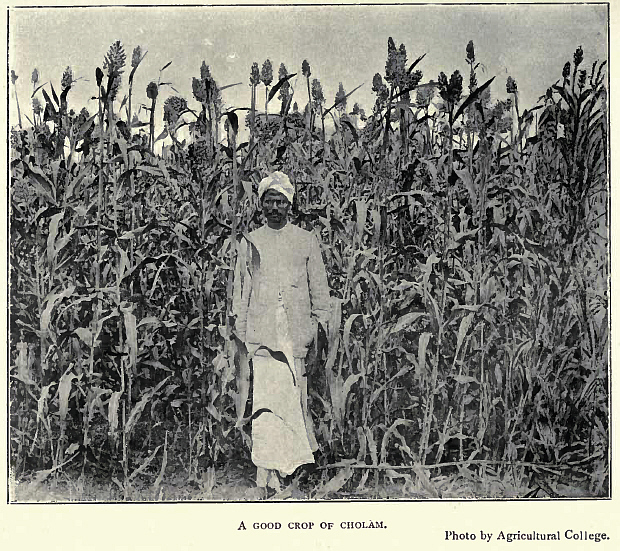
Abb.: Crop of cholam (Panicum miliaceum)
Ownership and cultivation. There were, in 1911, the year of resettlement, 72 single pattadars, and 60 joint pattas, making a total of no less than 256 separate landowners. Of these 250 cultivate their own land, and the six who let their land (46.46 acres) include three temple priests, two petty officials, and one old woman. The village is therefore one of almost perfect peasant proprietorship ; just over two-thirds of the 395 families, apart from the pariahs, own land, and the average size of the estate of each family is 3 acres. Much of the land is good black loam, and where there is water enough two crops of paddy and one of cholam (the great millet), are raised. Groundnut is grown on 85 acres which have the most precarious water-supply ; and nearly all the rest of the cultivated area yields two crops of millet (cholam, ragi and kambu) per annum. The stock list reads
Working oxen 308
Cows 164
Buffaloes 109
Young of above species 296
Donkeys 6
Horses 15
Sheep and goats 880
Pigs 200
There is therefore a pair of working oxen or buffaloes to less than 4 acres of land.
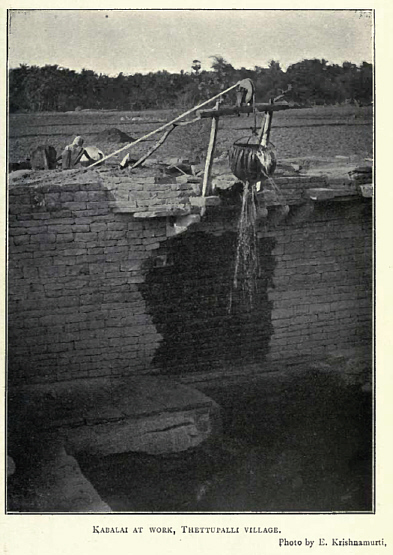
Abb.: Kabalai
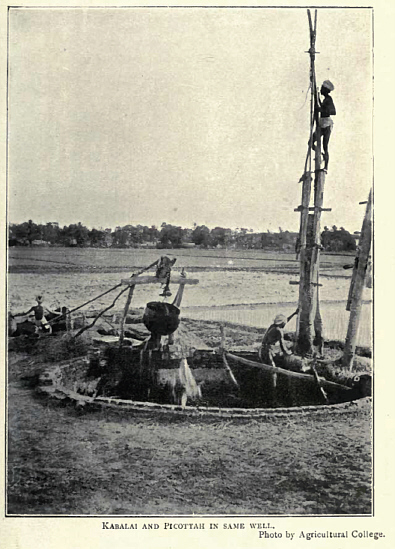
Abb.: Kabalai and Picottah
The kabalai. 1 The steady work of irrigation, particularly since the deepening of the wells, keeps the working cattle well employed. The wells are worked by the ordinary South Indian bullock-lift, and the kabalai, also used in Mesopotamia, and probably, both in India and in Mesopotamia, of immemorial antiquity. The oxen [S. 21] Work on an inclined plane which slopes downwards from the edge of the well. Descending the slope they drag up the kabalai, then they are made to back up the slope, and the kabalai is lowered to the water level. The kabalai is a big bucket of leather or metal somewhat less than two feet in diameter, continued below in a leather tube about four or five inches in diameter, and between two and three feet long. When the kabalai is being raised from the water, the top of the bucket and the end of the leather tube are level, each being attached to its own rope, and the two ropes being dragged simultaneously by the oxen. But the rope attached to the bucket passes over a pulley about four feet above the ground level, that attached to the tube, over a roller at the ground level. When the oxen are near the end of their run the open end of the tube is pulled over the roller, and as the bucket is raised still higher towards the pulley, the whole of the water in the kabalai is poured out and flows by a prepared channel in the desired direction.
1 Or Kamalai.
It may reasonably be assumed that this bullock lift has been unmodified for thousands of years. But quite recently a Mr. Ramachandran of Madras has invented an ingenious variation. He increases the steepness of the slope, lays down rails, and puts on them a little platform mounted on low wheels. A single ox takes the place of the pair, and faces towards the well instead of away from it. The platform is attached to the kabalai ; the ox has to drag the platform up the slope, then stand on it, and slide backwards down the slope, pulling up the kabalai as he does so. It is said that one ox can thus lift as much water in a day as a pair with the ordinary lift. I cannot at present vouch for the accuracy of this claim, as the one attempt at demonstration which I witnessed was a failure. The framework of the pulley was badly constructed and broke under the strain as soon as operations began.
On the basis of these preliminary inquiries, I drew up a "Village Questionnaire," as a guide to students in the investigation of their own villages ; and the following Village Surveys were worked out in the basis of that questionnaire.
The first two were made by students who had taken the degree of B.A. with Honours in History and Economics of the University of Madras, the remainder by students who were preparing for that examination, during the long vacation of 1916, and in some cases revised in that of 1917. Each student chose his own village, it might be his native village, or some other village where he had friends, and where it was convenient for him to spend the vacation.
Zu: 5.5. An Indian village / by Samuel John Thomson (1913)